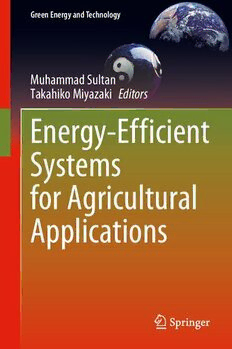Table Of ContentGreen Energy and Technology
Muhammad Sultan
Takahiko Miyazaki Editors
Energy-Ef ficient
Systems
for Agricultural
Applications
Green Energy and Technology
Climate change, environmental impact and the limited natural resources urge
scientificresearchandnoveltechnicalsolutions.ThemonographseriesGreenEnergy
and Technology serves as a publishing platform for scientific and technological
approaches to “green”—i.e. environmentally friendly and sustainable—technolo-
gies. While a focus lies on energy and power supply, it also covers “green” solu-
tions in industrial engineering and engineering design. Green Energy and Tech-
nology addresses researchers, advanced students, technical consultants as well as
decision makers in industries and politics. Hence, the level of presentation spans
frominstructionaltohighlytechnical.
**IndexedinScopus**.
**IndexedinEiCompendex**.
Moreinformationaboutthisseriesathttps://link.springer.com/bookseries/8059
·
Muhammad Sultan Takahiko Miyazaki
Editors
Energy-Efficient Systems
for Agricultural Applications
Editors
MuhammadSultan TakahikoMiyazaki
DepartmentofAgriculturalEngineering, DepartmentofAdvancedEnvironmental
FacultyofAgriculturalSciences ScienceandEngineering,Faculty
andTechnology ofEngineeringSciences
BahauddinZakariyaUniversity KyushuUniversity
Multan,Pakistan Fukuoka,Japan
ISSN1865-3529 ISSN1865-3537 (electronic)
GreenEnergyandTechnology
ISBN978-3-030-86393-7 ISBN978-3-030-86394-4 (eBook)
https://doi.org/10.1007/978-3-030-86394-4
©TheEditor(s)(ifapplicable)andTheAuthor(s),underexclusivelicensetoSpringerNature
SwitzerlandAG2022
Thisworkissubjecttocopyright.AllrightsaresolelyandexclusivelylicensedbythePublisher,whether
thewholeorpartofthematerialisconcerned,specificallytherightsoftranslation,reprinting,reuse
ofillustrations,recitation,broadcasting,reproductiononmicrofilmsorinanyotherphysicalway,and
transmissionorinformationstorageandretrieval,electronicadaptation,computersoftware,orbysimilar
ordissimilarmethodologynowknownorhereafterdeveloped.
Theuseofgeneraldescriptivenames,registerednames,trademarks,servicemarks,etc.inthispublication
doesnotimply,evenintheabsenceofaspecificstatement,thatsuchnamesareexemptfromtherelevant
protectivelawsandregulationsandthereforefreeforgeneraluse.
Thepublisher,theauthorsandtheeditorsaresafetoassumethattheadviceandinformationinthisbook
arebelievedtobetrueandaccurateatthedateofpublication.Neitherthepublishernortheauthorsor
theeditorsgiveawarranty,expressedorimplied,withrespecttothematerialcontainedhereinorforany
errorsoromissionsthatmayhavebeenmade.Thepublisherremainsneutralwithregardtojurisdictional
claimsinpublishedmapsandinstitutionalaffiliations.
ThisSpringerimprintispublishedbytheregisteredcompanySpringerNatureSwitzerlandAG
Theregisteredcompanyaddressis:Gewerbestrasse11,6330Cham,Switzerland
Contents
Maisotsenko-CycleAssistedDesiccantDehumidificationSystem
ConfigurationsforAgriculturalProductStorage ..................... 1
MuhammadH.Mahmood,MuhammadSultan,andTakahikoMiyazaki
DesiccantDehumidificationCoolingSystemforPoultryHouses
inMultan(Pakistan) ............................................... 19
MuhammadAleem,MuhammadSultan,MuhammadH.Mahmood,
andTakahikoMiyazaki
Evaporative Cooling and Desiccant Dehumidification Air
ConditioningOptionsforLivestockThermalComfort ................ 43
HafizS.Ullah, MuhammadSultan, MuhammadH.Mahmood,
HadeedAshraf,MuhammadIshaq,andTakahikoMiyazaki
Desiccant Dehumidification System for Storage of Fruits
andVegetables .................................................... 65
MuhammadIshaq, MuhammadSultan, MuhammadAleem,
MuhammadBilal, HafizS.Ullah, MuhammadH.Mahmood,
andTakahikoMiyazaki
Zero-EnergyCoolChamberforTomatoStorage ...................... 85
MuhammadKhalid,MuhammadH.Mahmood,MuhammadSultan,
MuhammadN.Ashraf,andTakahikoMiyazaki
EvaporativeandDesiccantAir-ConditioningSystemsforWet
Markets .......................................................... 101
MuhammadN.Ashraf,MuhammadH.Mahmood,MuhammadSultan,
MuhammadKhalid,andTakahikoMiyazaki
v
Maisotsenko-Cycle Assisted Desiccant
Dehumidification System Configurations
for Agricultural Product Storage
MuhammadH.Mahmood,MuhammadSultan,andTakahikoMiyazaki
Abstract Agricultural products storage and postharvest losses are linked with
optimaltemperaturehumidityconditions.Inthisregard,desiccantair-conditioning
(DAC) technology is investigated due to its ability to control the temperature and
humidity distinctly. Six kinds of evaporative cooling-assisted DAC system config-
urations are thermodynamically investigated using heat/mass transfer balance for
climatic conditions of Fukuoka (Japan). In case of S-II,S-IV,and S-VI configura-
tions,therearenodirectevaporativecooler(DEC)inregenerationairstream.These
configurationsprovidedhigherdehumidificationwithlessregenerationheatdueto
provisionofregenerationairstreamtoheatexchangerathighdrybulbandlowdew
pointtemperatures.SystemconfigurationS-Vachievedhighercoolingcapacityand
thermalCOPduetoconsiderationofDEConregenerationairstreamwithoutconsid-
eringindirectevaporativecooleronsupplyairstream.Threeefficientconfigurations
(S-II,S-IV,andS-V)arefurtherevaluatedforagriculturalproductstorageandother
applications.TheS-IIconfigurationachieveslatentloadatregenerationtemperature
of 80 °C; however, the modification of two-stage cooling is suggested in S-II to
achievethesensibleloadforstorageofagriculturalproducts.Itcanalsoemployfor
greenhouseairconditioningevenatlowregenerationtemperaturedependingupon
thetypeandgrowthstageofthecrop.
· ·
Keywords Desiccantdehumidification Evaporativecooling Systems
· ·
configurations Agriculturalproductstorage Thermodynamicanalyses
B
M.H.Mahmood·M.Sultan( )
FacultyofAgriculturalSciences&Technology,DepartmentofAgriculturalEngineering,
BahauddinZakariyaUniversity,BosanRoad,Multan60800,Pakistan
e-mail:[email protected]
M.H.Mahmood
e-mail:[email protected]
T.Miyazaki
DepartmentofAdvancedEnvironmentalScienceandEngineering,FacultyofEngineering
Sciences,KyushuUniversity,Fukuoka816–8580,Japan
e-mail:[email protected]
©TheAuthor(s),underexclusivelicensetoSpringerNatureSwitzerlandAG2022 1
M.SultanandT.Miyazaki(eds.),Energy-EfficientSystemsforAgriculturalApplications,
GreenEnergyandTechnology,https://doi.org/10.1007/978-3-030-86394-4_1
2 M.H.Mahmoodetal.
Nomenclature
φ Slopeofenthalpyline
h
φ Slopeofdehumidificationline
deh
AC Airconditioning
COP Thermalcoefficientofperformance[–]
DAC Desiccantair-conditioning
DEC Directevaporativecooling
DC Desiccantmaterial
ε Effectiveness[–]
HX Heatexchanger
MEC Maisotsenkocycleindirectevaporativecooler
PA Processair
RH Relativehumidity[%]
SA Supplyair
T Temperature[°C]
X Humidityratio[g/kg-DA]
Subscripts
i Inletcondition
o Outletcondition
reg Regeneration
wb Wetbulb
dp Dewpoint
1 Introduction
Energy-efficient, environmental-friendly, and low-cost agricultural storage is a
burningissueoftwenty-firstcenturyduetoelevatedpostharvestlosses(PHL).PHL
aregenerallydescribedasthelossesofqualityandquantityofagriculturalproducts
(fruitsandvegetables)[1].Agriculturalproductlossesaregloballyreportedashigh
as50%[1,2],outofwhich54%and46%haveoccurredduringproduction,posthar-
vesthandling,storage,andprocessing,distribution,consumption,respectively[2–4].
PostharvestlifeofproductsismostlyextendedbycombatingPHLthroughcoldstor-
ages [5]. The vapor compression refrigeration/air-conditioning (VAC) systems are
employedintoday’scoldstoragesfortheprovisionofstorageconditions(tempera-
tureandrelativehumidity)toagriculturalproducts.Thesesystemscontrolthestorage
temperature (T) precisely but the relative humidity (RH) indirectly [6]. The VAC
systemshavecertainthermodynamicandstoragelimitationsotherthanconsuming
Maisotsenko-CycleAssistedDesiccantDehumidificationSystem… 3
higherenergyandcausingenvironmentaldeterioration.Bothlimitationsincludeless
supply of fresh air, anaerobic respiration, poor ventilation, chilling injury, discol-
oration,etc.[1,5–7].TheexcessiveaccumulationofCO (poorventilation)results
2
indetrimentaleffectsonstoredproducts[1,5,6,8–10].Ontheotherhand,thermally
drivendesiccantair-conditioning(DAC)systemhasabilitytodistinctlycontrolthe
temperature and relative humidity [11, 12]. Such distinctive control is crucial for
thequalitative,nutritive,andquantitativestorageofagriculturalproducts[1,5–7].
Theoptimalstoragezoneofsomefreshagriculturalproductsisestablishedonthe
psychrometricchart[1,13].Thiszoneisfurthercomparedwithgreenhousegrowth
[14]andhumanthermalcomfort[15–17]conditionsasshowninFig.1[1,13–17].
ItisapparentfromFig.1thattherequirementofTandRHisdifferentinsaidappli-
cations.Therefore,differentvariantsofDACconsistofdesiccantdehumidification
and/orevaporativecoolingareinvestigatedforthepurpose.
In this study, four configurations of DAC system are proposed and thermody-
namicallyinvestigatedincomparisonwithtwobasicconfigurations.Thedesiccant
dehumidification performance of all proposed system configurations is evaluated
bythecontrolstrategyutilizingexperimentallyvalidatedslopeofdehumidification
line.However,thesensibleloadofairconditioningisdeterminedbyexperimentally
validated correlation, and fundamental thermodynamic expressions. The efficient
DACconfigurationsarefurtherpsychrometricallyanalyzedforagriculturalproduct
storageincomparisonwithhumanthermalcomfortandgreenhouseairconditioning.
Greenhouse growth conditions [14]
Agricultural products storage [1,13]
Human thermal comfort [15-17]
Fig.1 Establishmentofagriculturalproductstoragezone,humanthermalcomfort,andgreenhouse
growthconditionsonpsychrometricchart
4 M.H.Mahmoodetal.
2 ProposedSystemsandResearchMethodology
Batch-typeDACsystemconsistsoftwodesiccant(DC)unit,aheatexchanger(HX),
aMaisotsenkocycleindirectevaporativecooler(MEC),adirectevaporativecooler
(DEC),andheatsourcewhichisshowninFig.2.Accordingly,fourconfigurationsof
DACsystemareproposedandthermodynamicallyinvestigatedincomparisonwith
two basic configurations. The basic system configurations are labeled as System-I
(S-I) and System-II (S-II) [5]. The proposed system configurations are termed as
System-III (S-III), System-IV (S-IV), System-V (S-V), and System-VI (S-VI) in
thisstudy.Thebasic[5]andproposedsystemconfigurationscommonlycontaintwo
desiccantunitsandaheatsource.However,theothercomponentsareusedalterna-
tivelyinthesystemconfigurations.Twounitsofdesiccantareusedtoenabletheir
switching during regeneration and dehumidification. The schematics of proposed
configurationsalongwithpsychrometricrepresentationsareshowninFig.3a–d.It
is worthy to mention that system configurations (S-I to S-IV) employ the MEC to
achievethesensibleloadofAC.Incontrastwithconventionalindirectevaporative
coolingmethods,theMECutilizesnoveldewpointevaporativecoolingconception
viaMaisotsenkocycle[12].Therefore,MEChasanabilitytocooltheairbelowits
wetbulbtemperatureandapproachestothecorrespondingdewpoint[12].Referring
toFig.2,theworkingprincipleoftheproposedsystemcanbebrieflyexplainedas:
theambient/processair(1)passedthroughdesiccantandbecomedehumidifiedwhen
exits at condition (2). The dehumidified air (2) is initially cooled by HX followed
byMECwhichexitsatconditions(3)and(4),respectively.Thesupplyair(SA)at
condition(4)canbeusedfortherelevantapplication.Thedesiccantsarerequiredto
beregeneratedfortheircyclicusage.Therefore,theworkingairatcondition(5/1)
initially passes through the DEC (6) followed by HX (7). HX is used to recover
the heat of adsorption of the dehumidified air. The warm working air at condition
(7) is further heated by the heat source. The hot working air (8) at certain regen-
erationtemperaturepassesthroughthedesiccantfortheirregeneration.Finally,the
regenerationair(9)isexhaustedtotheatmosphere.
Thedetailedmethodologyadoptedfortheanalysesofproposedsystemsisshown
inFig.4.Whentheambient/processairpassesthroughthedesiccant,itbecomesdehu-
midifiedandconsequentlyitstemperatureincreasesandrelativehumiditydecreases.
Regeneration air Working Working Working Working air
(hot and humid) air (hot) air (warm) air (cool) (ambient conditions)
DC-2 HS DEC
Heat source X
Desiccant H
Agri.
DC-1 MEC products
Process air Dehumidifiedair Sensibly Supply storage
(ambient conditions) cool air air
Fig.2 Schematicofbatch-typedesiccantair-conditioningsystem

